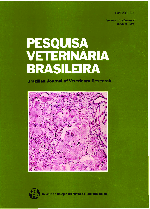 |
|
|
|
Year 1997 - Volume 17, Number 1
|

|
Experimental poisoning by the ground seeds of Ricinus communis (Euphorbiaceae) in the rabbit, 17(1):1-7
|
ABSTRACT.- Brito M.F. & Tokamia C.H. 1997. [Experimental poisoning by the ground seeds of Ricinus communis (Euphorbiaceae) in the rabbit.] Intoxicação experimental pelas sementes trituradas de Ricinus communis (Euphorbiaceae) em coelhos. Pesquisa Veterinária Brasileira 17(1):1-7. Projeto Saúde Animal Embrapa/UFRRJ, Km 47, Seropédica, Rio de Janeiro 23851- 970, Brazil.
The ground seeds of Ricinus communis L., given by stomach tube in single doses to rabbits, caused severe symptoms of poisoning, lethal in three rabbits which received the dose of 2 g/ kg and in one of four rabbits which received 1 g/kg; the other three rabbits which received the lower dose, showed slight to moderate symptoms and recovered. Three other rabbits, which received 0.5 g/kg, showed only slight symptoms. The period between administration of the seeds and death or recovery, varied from 12h47min to 68h08min, and from 3 to 6 days, respectively. First clinical symptoms after the administration of the seeds were observed about 8 hours in the lethal cases and in those where the animals showed more than slight symptoms, and about 24 hours in the cases with only slight symptoms. The course of the poisoning varied from 4 to 56 hours in the lethal cases and froin 2 to 5 and half days in the cases with recovery. The clinical signs consisted mainly in digestive distress; the animals showed inappetence or anorexia. Faeces were generally scarce, with bolus altered in form and size, dark, sometimes soft, with mucus. There were manifestations of colic. The most evident post-mortem findings were in the small intestine and cecum, which had liquid contents; its wall was congested and edematous, and fibrine covered the mucosa as pseudomembranes or was found in the lumen as flakes and or filaments. The most important histological changes were seen also in the small intestine and cecum. In the former there was coagulative necrosis associated with congestion/ hemorrhages of the mucosa and submucosa which also showed edema. Similar lesions were seen in the cecum, but thése were less marked, with exception of the edema of the submucosa. In colon and rectum the changes were slight or absent. Necrosis with marked caryorhexis of the macrophages, which migrated to the upper mucosal layer, was seen in the lymphoid follicles of the appendix vermiformis and in one case also of the rudimentary cecum. |
| |
|
|
| |
|
 |